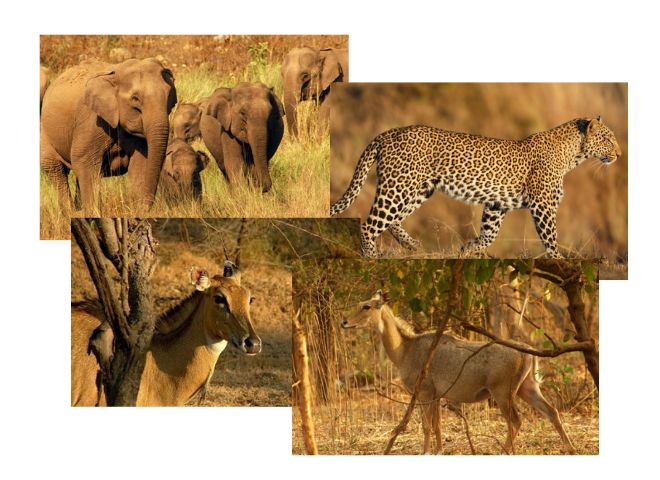Rajaji has plants from both the Himalayan and Upper Gangetic plains. Its location between these two regions makes it home to a wide variety of wildlife habitats. It has eight main forest types. The Khair-Sissoo forests are also on the southern slopes. The Low Alluvial Savannah Woodlands are on the reserve's southern edges. The Shivalik Chir-Pine Forests on the higher hills add to the area's rich biodiversity.
Tall Sal trees and other plants fill the northern side of Rajaji. Some trees can reach up to 80 feet tall and 5 feet wide. From February to March, the Sal trees change color. They transition from brown-red to pale green to dark green. In March and April, the forest smells sweet from the blooming Sal trees. Many fruit trees attract a variety of birds and mammals. Elephants to rats eat the fruits of the Harar and bahera trees. Rajaji has other fruit trees. They include Jamun, Ber, Chilla, Ficus, Lassora, Aonla, Sisham, and Bel. These trees make up 30 different species.


Rajaji Tiger Reserve is home to 49 mammal species. The wildlife reserve includes Asian Elephants and Tigers. The reserve houses around 310-350 elephant. It also houses over 30 tigers and 170 leopards. The Chilla and Gohri ranges are home to tigers. They also live in the surrounding buffer zone. Mountain goats, known as goral, are unique to Rajaji's steep hills. The reserve also hosts striped hyenas and jackals. You can also spot other animals and birds. Migrating birds and animals are also common. These include sambhar, elephant, cheetal, barking deer, wild boar, nilgai, and jungle cat. You may also spot langur, tiger and leopard cats. You could also see the Indian pangolin. You could also see the small Indian civet and Himalayan yellow-throated marten. You may also see smooth-coated otters, porcupines, tigers, Himalayan black bears, and sloth bears. Yet, the bears are only visible in winter. They appear at the northern edge of the Chilla range and the eastern edge of the Gohri range.
The reserve is home to various reptiles. These include snakes, lizards, turtles, and tortoises. Rajaji has 15 types of snakes, from the large Burmese Python to a small, blind snake. Most snakes in Rajaji are harmless and non-poisonous. The snakes include the buff striped keelback, common cat snake, trinket snake, bronze back, spotted wolf snake, black-headed snake, and rat snake. There are also poisonous snakes, such as the spectacled cobra, common krait, and king cobra. The King Cobra is the world's largest poisonous snake and can grow up to 18 feet. It's the only snake that builds a nest with leaves. Other snakes lay eggs underground.
Rajaji National Park also has 11 types of lizards from 8 different groups. These include geckos, skinks, garden lizards, and watch lizards. None of them are poisonous. The reserve is also home to 10 species of amphibians like frogs and toads.